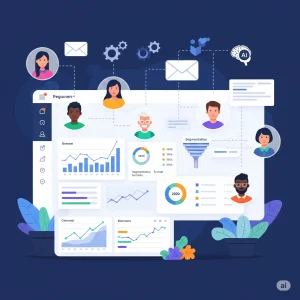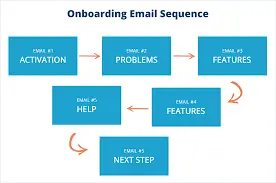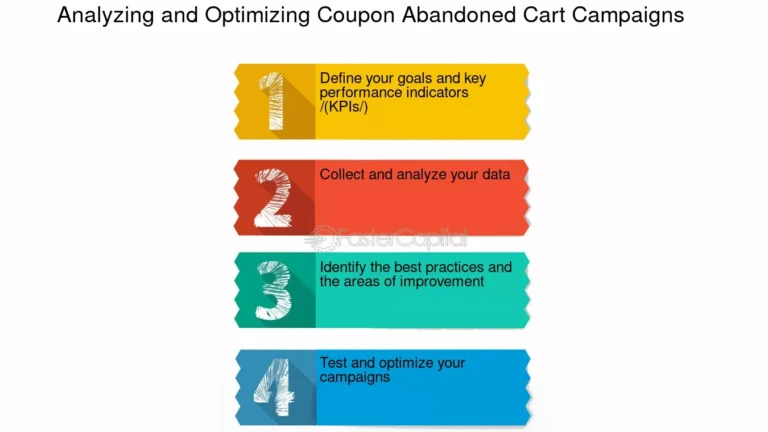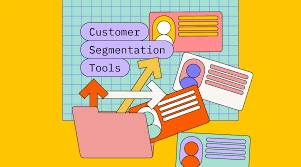What Segmented Email Sequences SMBs Must Use

Every email count for a small business. Generic blasts are out – personalized, segmented email sequences are in. Studies show that relevant email journeys dramatically boost engagement and ROI. In fact, one report found marketers saw a 760% increase in revenue from segmented campaigns. By slicing your audience into targeted lists and sending each the right message, you cut through inbox clutter.
As a VizLeads analysis found, open rates are the “gatekeeper” of email success – if your emails aren’t opened, nothing else matters.
Segmentation and automation for SMBs solve this: they ensure your messages land at the right time for the right people, so more subscribers actually open and engage.
In a global market, that means crafting emails that speak directly to each subscriber’s needs and even their location (timezone, currency, language). In short, segmented email sequences are essential for SMBs that want to nurture leads and drive conversions instead of getting ignored. They turn email marketing for small businesses into a high-ROI, audience-driven growth engine.
What Is Email Segmentation & Why It Works

Email segmentation (or list segmentation) is the practice of dividing your email subscribers into smaller, targeted groups based on traits like interests, behavior, demographics, or location. For example, you might segment by past purchase (dog owners vs cat owners), by engagement level, or by geographic region. Each segment then gets customized content and offers that resonate with their profile.
This “divide and conquer” approach works because more relevant content gets better results. Research shows segmentation reliably boosts open rates, clicks, conversions, and ROI, while cutting down unsubscribes and spam bounces.
For instance, Mailchimp notes that segmented campaigns improve open rates and clicks because subject lines and content are tailored to the audience.
Klaviyo similarly advises that sending “fewer, better-targeted messages” by splitting subscribers into smart segments yields higher engagement and loyalty.
- Higher engagement: When you send people content that fits their interests or stage of the buyer journey, they respond. Segmented emails get opened and read at much higher rates.
- More conversions: Targeted emails guide subscribers closer to purchase. Mailchimp reports that segmented campaigns spur more clicks and conversions, because each email contains the info a particular group needs to move forward.
- Improved ROI and revenue: By sending each message to the most receptive audience, you maximize your budget. Campaign Monitor found that 77% of email ROI comes from segmented, targeted campaigns. Similarly, personalized subject lines alone can increase opens by 26%.
- Fewer unsubscribes and spam flags: Generic blasts often frustrate readers. In contrast, relevant emails keep subscribers happy and engaged. As Zapier notes, segmentation “provides an individualized experience via a mass medium,” making recipients feel valued. In turn, you avoid annoying people and triggering spam filters.
In practice, segmentation data can include anything tied to a customer email: sign-up source, industry, purchase history, web behaviors, and more. The more you know about your contacts, the smarter you can split them into segments. The result? Each person gets emails that “speak” to them, rather than generic blasts that many just delete. The takeaway: smart segmentation makes your email marketing for small businesses far more effective by delivering the right message at the right time.
Five Must-Use Segmented Email Sequences for SMBs
1. Welcome/Onboarding Sequence

A welcome sequence greets new subscribers or customers and sets the tone for your relationship. This is one of the most critical sequences because it establishes trust and brand awareness from the outset. As soon as someone signs up (via a form, checkout, etc.), the first email should arrive right away, thanking them and introducing your value. Follow it up over the next few days with 2–4 additional emails: share your story, highlight top products or resources, and reinforce what makes you special.
- Content ideas: Thank-you message, brand story or mission, how-to guides, top product/service highlights, and expectations for future emails.
- Why it matters: An effective welcome series “gains your subscribers’ trust, ensuring they open and read other emails you’ll send”. It primes customers for future offers and familiarizes them with your brand voice.
- Segmentation tip: Even in your welcome flow, you can segment by source or interest. For example, new leads from a webinar might get a different series than those who joined via an eBook download.
2. Subject Line Nuances That Drive Clicks

A drip campaign is a multi-email sequence designed to move a lead through your sales funnel from interest to purchase. Whenever someone takes a key action (like downloading a whitepaper or requesting more info), trigger a drip sequence that delivers valuable content over time. Each email should build on the last, providing education, case studies, or offers that make the prospect more informed and ready to buy.
- Content ideas: Industry insights, problem-solving content, testimonials, demo invitations, and tailored offers.
- Why it matters: Drip sequences nurture leads consistently. By “taking a lead from the interest stage of your funnel to being a paying customer”, they keep your brand top-of-mind and gently guide the decision process. Instead of losing leads to follow-up fatigue, you automate the right touchpoints so interested prospects steadily move toward a sale.
- Segmentation tip: Trigger drips based on lead behavior (e.g. downloaded X resource), and adjust content by segment. For instance, send shorter educational sequences for quick-buy industries, and longer, more detailed sequences for complex B2B purchases.
3. Behavioral Segmentation Sequence

Behavioral sequences react to what your subscribers actually do (or don’t do). These flows use data from email clicks, website Browse, purchase history, etc., to send super-personalized messages. For example, if a customer views a product page or adds an item to cart but doesn’t convert, you can trigger a targeted follow-up. According to marketing platforms like Drip, you can “build behavioral and life cycle segments that dynamically update” so customers seamlessly move into relevant flows.
- Content ideas: Product recommendations, review requests, or relevant cross-sells triggered by specific actions (e.g. “You viewed X, here’s why customers love it”).
- Why it matters: This strategy makes your emails feel highly timely. For instance, customers who engage with certain products get emails about those products or similar ones. This level of personalization dramatically increases relevancy. (In fact, Drip claims customers who use segments earn 5× more revenue than those who don’t.)
- Segmentation tip: Common triggers include web page visits, link clicks, previous purchases, or survey answers. The goal is to automatically update segments in real time and send follow-ups or special offers based on the latest behavior.
4. Re-Engagement/Inactivity Sequence

No one stays active forever. A re-engagement sequence (a “win-back” flow) targets subscribers who have gone quiet – for example, those who haven’t opened your emails or made a purchase in a while. Mailchimp suggests sending this when you notice a segment’s open rates have dipped or purchase frequency has stopped. Typical triggers might be 90 days of inactivity, a decline in site visits, or no purchase after a previous order.
- Content ideas: “We miss you” messages, requests to update preferences, and special incentives (like a discount or exclusive content) to entice them back. Remind them why they subscribed and the value you offer.
- Why it matters: A well-crafted re-engagement email can rekindle interest and keep your list clean. Mailchimp notes key indicators such as low open rates, infrequent site visits, or lack of recent purchases as signals to reach out. By segmenting out inactive subscribers and gently trying to win them back, you improve overall campaign performance. (If they still won’t engage, it’s better to clean them from your list to protect deliverability.)
- Segmentation tip: Use your email platform’s tools to isolate “at-risk” subscribers. For example, create a segment of contacts who haven’t engaged in 3+ months. Then automate a short series (e.g., 2–3 emails) that builds up: a friendly check-in, an incentive offer, and finally a confirmation of their subscription.
5. Abandoned Cart/Sale Opportunity Sequence

For any e-commerce or sales-driven SMB, an abandoned cart or opportunity flow is a must. It targets people who have signaled intent but didn’t complete a sale – such as visitors who added items to cart or started a signup but left. By following up, you recover potentially lost revenue. Campaign Monitor reports that customers who receive automated abandoned cart emails are 2.4× more likely to complete their purchase.
- Content ideas: Send reminders about the cart or opportunity, include product images and benefits, and consider including a small discount or free shipping offer in later emails. For non-ecommerce SMBs (like service providers), treat an abandoned inquiry similarly by following up with additional information or incentives.
- Why it matters: This sequence turns missed opportunities into sales. Gentle reminders capitalize on the moment when the prospect was interested. Often, a friendly nudge is all it takes to get them over the finish line. The increased conversions from abandoned cart flows make them one of the highest-ROI automated campaigns.
- Segmentation tip: Segment contacts by their position in the funnel. For example, people who visited the checkout page but didn’t purchase go into the cart recovery flow. Ensure you end the sequence if a purchase or commitment is made.
Advanced Segmentation Strategies & Tools

As email tech evolves, so do segmentation tactics. Advanced strategies use dynamic, data-driven methods. For example, you can employ AI and predictive analytics to create “smart” segments. Emarsys (SAP) notes that machine learning allows brands to “spot patterns” and segment customers “based on real-time behavior”, constantly updating as data comes in. In practice, that might mean automatically moving a subscriber into a “hot lead” segment if they frequently open emails or visit pricing pages.
Modern email platforms support these strategies. Tools like Klaviyo, Drip, ActiveCampaign (and others) have powerful automation and segmentation features. Klaviyo integrates deeply with e-commerce (Shopify, WooCommerce, etc.) to track purchase habits and site activity, enabling detailed segments (by product interest, CLV, etc.). ActiveCampaign excels in advanced workflows and conditional content for lifecycle automations. Drip emphasizes simple, behavioral segments that update automatically. Whatever the platform, the key is that you can treat your contacts like individuals, not one big list.
Importantly, VizLeads helps SMBs tie it all together. We specialize in integrating these email tools with CRMs and other systems. (Our team are CRM integration experts, so your data flows seamlessly from e-commerce or CRM into the email platform.) This means your segmentation is as good as the data you feed in. VizLeads sets up data syncing, tags, and APIs so that segments in Klaviyo/Drip/ActiveCampaign always reflect the latest customer info. We also leverage any built-in AI features (for instance, Klaviyo’s AI-driven optimization or predictive churn scoring) to make segmentation smarter.
Tools and AI are great, but strategy is key. VizLeads builds advanced flows by combining your knowledge with best practices. We might use lead scoring to define engagement tiers, or set up dynamic content blocks that change based on segment. For example, an email template might automatically insert region-specific offers (GEO personalization) or a localized discount code. The goal is to use every feature of these platforms so each email feels hand-tailored. And because VizLeads is platform-agnostic, we can work across any tech stack.
Whether you’re on HubSpot, Salesforce, Klaviyo, Drip, or others, we’ll map your data and sequences accordingly. (Learn more about our data-driven email approach on our Email Marketing Services page.)
SEO/AEO/GEO Optimization Tips for Email Sequences
To make your email content as engaging as possible, apply content best practices used in SEO and localization:
- Use clear, compelling keywords: Just like web content, your subject lines and email headings should answer customer needs. Think of common questions your audience has and frame your content as the answer. This answer engine optimization (AEO) approach means your email immediately addresses what the reader cares about. For example, a subject like “How to fix [problem] in 3 easy steps” captures attention by promising an answer.
- Localize for GEO relevance: If you serve international or regional audiences, segment your list by location. Send emails that reference local events, languages or currencies. For instance, mention a city in the subject line (e.g. “Hi [City] business owner, we can help your email marketing!”). Adjust send times for time zones. This makes content feel timely and personal worldwide.
- Maintain a consistent brand voice: This isn’t SEO, but global audiences expect a coherent brand experience. Ensure your wording, design, and calls-to-action match what subscribers see on your site and ads. Familiarity builds trust.
- Optimize engagement cues: Use buttons and anchor text with action words (e.g. “Get Local Deals”, “Download Now”) to drive clicks. And always include alt text on images (for accessibility and in case images are blocked) – well-described images can indirectly aid AEO by explaining content.
- Test and iterate: Use A/B tests on subject lines and content. Over time, you learn which phrases or formats resonate. Smart send-time optimizations (often powered by machine learning) can also improve metrics. Track results in different regions and languages to continuously refine your localization strategy.
By treating your email sequence copy like search-optimized content, you ensure every word works to capture attention. The blend of SEO/AEO/GEO thinking keeps your messages relevant and maximizes engagement across different audiences and markets.
How VizLeads Builds & Manages These Sequences
At VizLeads, we don’t just set and forget – we systematically design and optimize every email sequence. Our process typically starts with a full audit of your existing emails and data.
Then we craft a strategy covering each of the key sequences above, tailored to your business goals. From there, we handle everything: strategy development, audience segmentation, content writing, design, coding, and deployment.
In fact, we describe a typical campaign as including “strategy development, audience segmentation, content creation, design, testing, deployment, and performance analysis”.
Here’s how it works step-by-step:
- Discovery & Audit: We analyze your customer data, existing lists, and any current email flows. This might reveal gaps (e.g. no re-engagement flow), or opportunities (like unused CRM tags for better segments).
- Segmentation Plan: Based on what we learn, we define the segments you need (new leads, engaged customers, etc.) and map out which sequence each segment will enter.
- Sequence Design: We outline each email in a sequence (e.g. 5-touch welcome flow, 3-touch cart recovery flow), including timing and triggers. We use proven copy and design templates, often A/B testing subject lines and preheaders to maximize opens.
- Build & Integrate: We build the campaigns in your email tool, setting up automation rules. We ensure the system is integrated with your CRM or e-commerce platform for up-to-date data. This means someone’s actions (like a purchase) automatically move them into the right segment or end their existing flow.
- Testing: Before sending live, we test thoroughly – checking email renderings, link tracking, dynamic content, and signup triggers. We often send trials internally for feedback.
- Launch & Monitor: Once live, we monitor deliverability and engagement. Within hours of deployment you can see opens and clicks. We adjust any technical issues immediately.
- Optimization: We continually analyze performance. This includes A/B testing elements, tweaking timing based on engagement, and refining segment criteria. We keep a close eye on benchmarks – for SMBs, small improvements in open or click rates can translate to big revenue gains. We also watch campaign-specific KPIs to ensure each flow meets its goals.
Throughout this process, you get transparent reporting. VizLeads provides regular analytics showing open rates, click-through rates, conversion rates, revenue impact, list growth, and unsubscribe rates for each sequence. We align reports with your goals (e.g. newsletter signup conversions or sales). The data-driven insights let us iterate: if a segment isn’t responding, we adjust the copy or timing. If an email underperforms, we test new creatives. In short, we treat your email program as a living strategy, always improving.
KPI Tracking & Continuous Optimization
Key metrics guide everything we do. For SMBs, the most critical KPIs are:
- Open Rate: Shows if your subject lines and send times are resonating.
- Click-Through Rate (CTR): Indicates how compelling your content and CTAs are.
- Conversion Rate: Tracks how many recipients take the desired action (purchase, signup, etc.) after clicking.
- Revenue per Email / ROI: The bottom-line impact of campaigns. We tie revenue back to each sequence to prove value.
- Unsubscribe & Spam Rate: Signs of audience health. A rising unsubscribe rate signals it’s time to refine content or list segmentation.
- Deliverability Rate: Measures inbox placement. Keeping bounces and spam complaints low protects your sender reputation.
VizLeads not only measures these but also campaign-specific KPIs. For example, in a lead-nurture drip we might track how many leads request a demo, or in an abandoned cart flow how many carts are recovered. All metrics are reported regularly with actionable insights.
From there, it’s a continuous loop. We might see a subject line is weak and test a new angle, or notice a segment isn’t engaging and update its criteria. The best campaigns are never “set it and forget it” – we continuously optimize content, timing, and targeting. Our goal is steady improvement: even small percentage gains in engagement can boost your revenue significantly.
Conclusion
Segmented email sequences are no longer optional – they’re essential for SMB marketing success. We’ve seen how targeted welcome, nurture, behavioral, re-engagement, and cart-abandonment flows can dramatically improve open and conversion rates. These data-driven sequences create a personalized experience that feels like one-to-one outreach. In fact, Campaign Monitor reports that an overwhelming 77% of email ROI comes from segmented, targeted campaigns – proof that this approach pays off.
If you’re ready to level up your email marketing for small businesses, VizLeads is here to help. We build, integrate, and optimize every sequence so that your business can focus on what you do best. Learn more about our Email Marketing Services and how our team can craft the ideal segmented campaigns for you.
Have questions or want to get started? Contact us today at VizLeads.co to see how smart email automation can turbocharge your lead generation and sales.